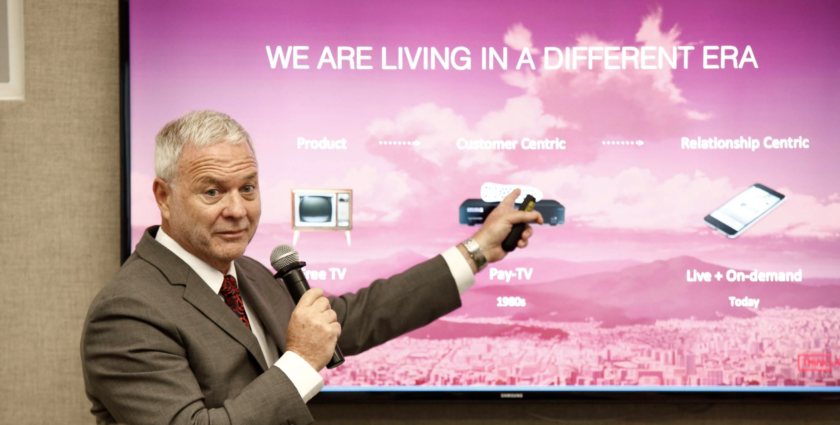
HITS Fall: Enhancing User Experience, Metadata Crucial in ‘Engagement Economy,’ ThinkAnalytics Says
Enhancing the video user experience, enhancing metadata and creating real-time campaigns have become increasingly important strategies for video platforms across the board to implement, according to ThinkAnalytics CEO Gabriel Berger.
The battle for customer engagement is sophisticated, intense and deserves a rapid response, according to ThinkAnalytics. In an increasingly crowded and competitive marketplace, where subscriber acquisition costs are high, winning video platforms are focusing on direct customer engagement to grow revenue, increase loyalty and reduce churn.
“We are in an engagement economy,” Berger said during the morning technology breakout presentation “Monetizing in the Engagement Economy” at the Oct. 4 Hollywood Innovation & Technology Summit (HITS) Fall event. During the interactive session, he demonstrated how easy it is to build, test and launch campaigns in minutes while at the same time improving customer data, refining content discovery and increasing key performance indicators (KPIs).
It’s also an “attention economy” in which all video platforms are “fighting for the same eyeballs,” he said, pointing to the importance of figuring out how to best engage audiences and then figuring out how that engagement manifests itself. Among the key forms of data that companies running video platforms can use to help figure that out are ratings and share engagement metrics, click-throughs and buy rates for pay-per-view programs, he said.
“But clearly engagement is what it’s all about,” he said, adding: “We talk about scale a lot. We talk about volume. We don’t talk about velocity.”
Yet, he said: “You’re seeing, more and more, content get faster. And what’s happened is there’s been an evolution. So, we’re living in a different era” – an era in which “you’re touching the customer all the time,” whether the video content is live or on demand.
As a result, what we’re increasingly seeing is “almost like linear becoming the new” video on demand (VOD), he said, adding: “It’s really kind of bizarre. Because you can hang social media feeds off of it. You can do all sorts of things.” The question for the organization operating a video platform, he said, then becomes: “How do you start to handle both live and on demand?”
Pointing to data showing the average user looked at the Netflix app for 1-2 minutes in which he or she browsed 20-50 titles to decide what to watch, he called that a small window of time in which the success or failure of a video service hung.
“That’s why we’ve got to talk about the variable of speed and how important it is,” he said.
To best enhance the video user experience and metadata, as well as develop effective real-time campaigns, he said, “what we’re looking for is something that’s immediate, ongoing, accurate, personalized, meaningful, [covers] all platforms and [is] nimble.”
Artificial intelligence (AI), machine learning (ML) and best practices, combined with “human intervention,” are all important, he said. But he stressed: “It all starts with the metadata.”
The ThinkAnalytics real-time content and recommendations engine handles 40 languages and is used in 33 countries now, he said, stressing the importance of supporting multiple languages. After all, he noted, the occupants of one house in Switzerland may speak multiple languages.
He went on to tell attendees: “There is a way you set things up correctly in how you use metadata.”
There are two “siloes” at Think Analytics. The first includes AI, ML and other technology” and then “the jet fuel is the metadata,” he said, noting that includes how an organization creates attributes “to make everything more meaningful; then we tie in machine learning.”
From there, it’s important to figure out conversion rates by seeing how many viewers used recommendations that were provided, he said, adding: “The last part is: How do you know? And how do you deal with time?”
He went on to say: “We love developers. They’re fantastic. But if you’re in a nimble environment and you want to make a change request and it goes to a developer and he’s got, I don’t know, 4,000 outstanding tickets of change requests that he has to get done — probably not an exaggeration — do you want that guy? He’s a great guy. But he probably has a weak stomach, irritable bowel syndrome and works 75 hours a week and not helping the situation at all because it’s not nimble enough. You’ve got to take things out of the data scientist’s hands and put it into the marketing program.” That’s how to get to the next important step, which is monetization, he said.
Although his company handles 2 billion recommendations a day, he said: “So what? Now what? That’s what it’s about.”
What Think Analytics has going for it, “more than anything else, is we’ve got 14 years of mistakes, of best practices — banging our head against the wall, saying ‘What works? What doesn’t?’ he said.
He provided an example of one ThinkAnalytics customer that has “millions and millions” of subscribers in Asia and “90 percent of what people watch is driven by the recommendations we make,” he said.
HITS Fall was sponsored by Amazon Web Services, Microsoft Azure, Box, Ooyala, TiVo, Cognizant, DXC Technology, Gracenote, LiveTiles, ThinkAnalytics, Wasabi, Aspera, EIDR, MicroStrategy, the Trusted Partner Network, human-I-T, Zaszou IT Consulting, OnPrem Solution Partners, and Bob Gold & Associates, and was produced by the Media & Entertainment Services Alliance (MESA), in association with the Content Delivery & Security Association (CDSA), the Hollywood IT Society (HITS), the Smart Content Council and Women in Technology Hollywood (WiTH).
Click here to download audio of the presentation.
